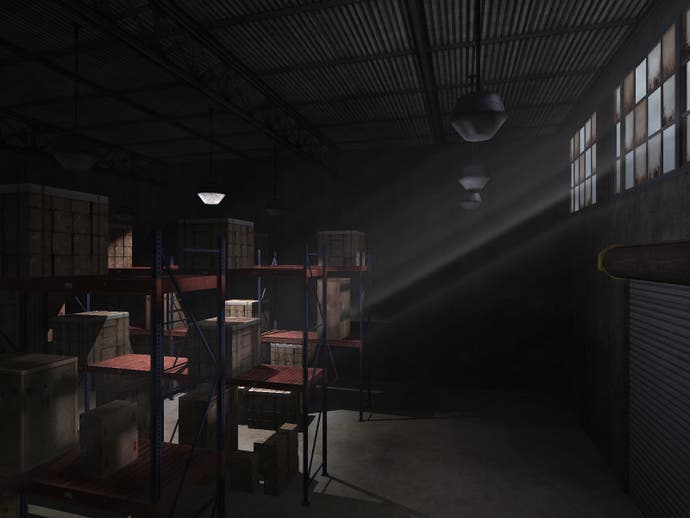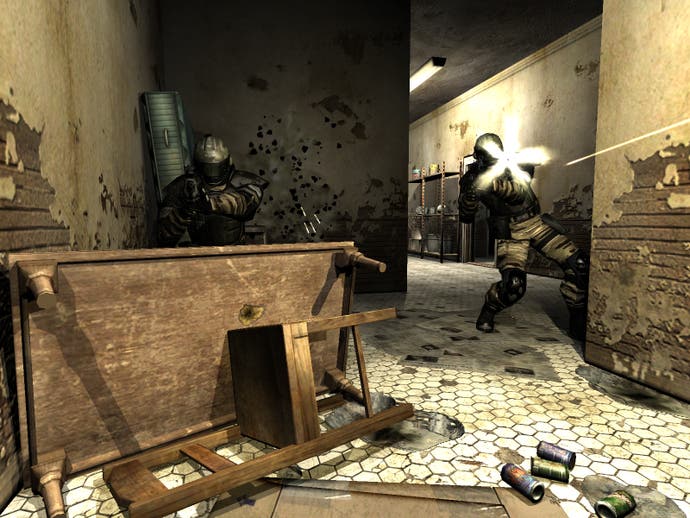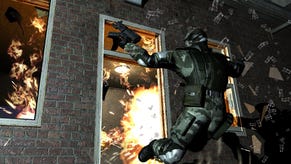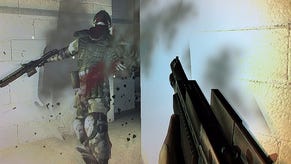F.E.A.R.
Supports arguments both for quick-loading and looking beyond Hollywood.
I've just died. Again. I knew about the first guy on the balcony, so I shot him through a window before descending to the ground floor and going outside. But I underestimated his partner.
He'd gone and hidden, see. I thought he was to the right of the door I was stepping out of, but he wasn't; he was up on the balcony crouched out of view, and as I stepped into the open he got his shot off. Fudging the keyboard with the base of my palm administered the last crucial health-pack and activated slow-motion mode and the down-the-barrel viewpoint, allowing me to respond quickly and accurately - the bullet leaving a tunnel of distorted and multi-coloured air in its wake like a streamer - but the damage was done. The thud of his crumpling body was the first crisp sound I heard as I disabled slow-mo and the dampened audio returned to normal. But it wasn't followed by an eerie silence; instead I heard the sound of a chopper.
Racing round to the stairway that led up to the balcony, reloading my railgun-esque super-zapper on the way, I knew the slow-mo had recharged sufficiently for me to fend off both the guys zipping down from the hawk-like shape hovering ahead, but then as I advanced the doors nearby crashed open and more troops swarmed into the open. Some leapt off the balcony and started firing from below, and even in slow motion their numbers were too great. I missed a vital rail-shot. The next rail connected and reduced my target to a cindered skeleton, but with no health-packs left and my slow-mo now drained, it was too much. The screen went red.
CUUUUUT!
With F.E.A.R., Monolith wanted to make an action movie in a first-person shooter. Those were the words they used when we grilled them about it earlier this year. In fact, it was virtually all they'd say. Going back, we wish we'd asked some different questions. Ah, going back.

Quick-loading just inside the doorway, I was ready this time. Doors open. Out I moved, gingerly, my sights already firmly on the spot where I knew my adversary would emerge. VOOO-oomp. Slow-mo. There he was, and then there he wasn't, as I railed him before he'd even raised his gun barrel. Oooo-OWOP. Slow-mo off. 4. Frag grenade selected. Chasing round to the stairway, I knew the chopper was coming. I knew about the guys waiting to burst from the doors. So I hurled a frag grenade so that it landed just in front of them and sprinted hard to the point I knew would trigger their emergence. It did - and just in time.
VOOO-oomp. I was just in time to see the growing bubble of the grenade's explosion blowing a cluster of soldiers to pieces. Stooping, I aimed down the barrel and took the first chopper-man out before he'd even started his descent; a cloud of bloody mist billowing to mark the kill. The second man made it half of the way down, but dropped the rest as a charred frame. Oooooo-OWOP. Ears pricked for further trouble, I moved forward cautiously. THUD. Worry. THUD-THUD.
Oh. It was a dismembered leg, barged off the balcony by my stumbling feet.
Through the blown-apart doorway. F5. Saved. And that's a wrap.

Right now you could reach for your anti-quick-save placards and start waving them, but we're not protesting. This isn't a debate about quick-save's role in the genre. To us, F.E.A.R.'s distinctiveness justifies quick-save's inclusion in a manner that you don't see in other first-person shooters. Bear with us.
Played on a suitable difficulty level, it's hard. Not tragically hard, but hard enough to kill you if you don't make efficient use of your slow-motion skill, and don't keep yourself alert to the health-number in the bottom left of the screen, which has to be topped up manually by administering health-packs with the Z key. Hard enough, in other words, to kill you if you don't direct the best scene possible.
Although you know the score when you re-emerge from the loading screen, the strength of F.E.A.R.'s visuals and its use of slow-motion to draw that spectacle out of its intensity mean that the scene you then act out - with a more informed performance, of course; unrealistically efficient as a result - can entertain you thoroughly. With enemies who manoeuvre into better positions, unafraid to knock things over en route; the three weapons you've kept ready to be called upon; the coupling of that spectacular slow-mo effect and the F.E.A.R. engine's many other visual excesses; and the tension-building need to marshal everything at your disposal effectively, it can give you what Monolith wanted to convey: that sense of being the hero in an action film. The drama, the intensity: the perfect outcome.

Without slow-mo and with dumber enemies, the quick-save/quick-load argument would be easier to make the other way. It would be the normal debate. What the slow-motion key gives you is the chance to actually see everything play out. Wading through the intensity of an FPS fire-fight can be like driving past a hill-top church silhouetted against the sunset and failing to comprehend it; your concentration lies with your actions rather than on what you're observing. The guy in the passenger seat is arguably better off. F.E.A.R.'s use of slow motion gives you the chance to drive and stare all at once.
And then it makes you jump.
That's the other side of it, unapparent in Monolith's "core concept" of an action movie FPS. F.E.A.R. is a fine harmony of FPS elements, but narratively it's been heavily influenced by Japanese horror, and that's its other momentous trick. The tension overflows from every fire-fight, and as a result the average stroll down a hallway is an uncomfortable experience. Then you slow down for reasons you can't figure out, and your heads-up-display stutters as audio intrudes from an unknown origin; the sound of a little girl laughing. Then an unmistakable shape disappears around a wall. Move forward and there's nothing there, and nowhere she could have gone.
When you mount a ladder to descend, your field of vision sweeps round with your turning body. When you do this later, you see her again for a split-second. This technique of capturing you in a bubble of tension and then stabbing it with the unnatural is something worth appreciating. And over the course of one level F.E.A.R. demonstrates its potential to do this a lot.

Of course, it demonstrates a lot of potential. One of the chief complaints about it is going to be the way it makes your new PC seem slightly creaky already, but if you can give it what it needs then the visuals are very strong. The audio is considered. The action is unmistakable. Thanks to a Gordon Freeman-esque "faceless, nameless" lead character, it's very involving - and this is used to horrify and engage. Only a few tweaks are needed for it to feel as good as its blueprint suggests it should do. The physics, for example. They can actually contribute to the tension; a dead body only slumping loudly to the floor a few seconds after the dust has settled and silence has rained in. But they can also cause undue panic and confusion by letting you snag your boot on a body, leading to an implausible thud-thud-thud as it moves. But it's very close.
One to watch, then - and, thanks to a gameplay device we've sometimes thought rather ordinary, one that you'll be able to watch very closely.
F.E.A.R. is due out later this year on PC. The single-player demo version is available now.







.png?width=291&height=164&fit=crop&quality=80&format=jpg&auto=webp)



